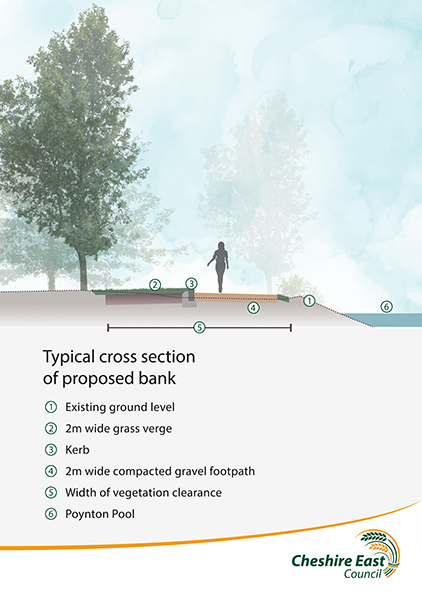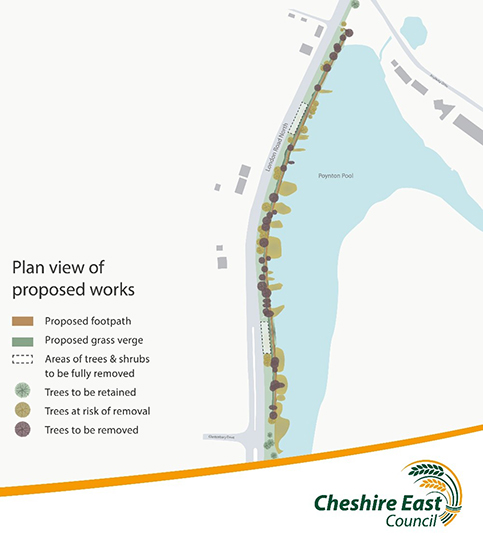Poynton Pool Spillway Improvements
Background
All bodies of water over 25000m3 must be inspected at least every 10 years as set out in the Reservoirs Act 1975. Data shows that greatest capacity of Poynton Pool is 130,000m3. The Council have a mandatory responsibility for Poynton Pool.
The last 10-year inspection of the pool found that a flood study and emergency draw down plan was needed.
The flood study found that the spillway capacity does not meet the standard set out in national guidance. Thus, the Council must carry out safety improvement works to the dam at Poynton Pool. These works will reduce the chance of it failing in an extreme weather event.
The dam is the earth embankment that retains the water in the pool. The dam sits between the edge of the pool and the B5092 London Road North. It extends for 800m along the western edge of the pool. In the event of extreme flooding, excess water flows over a spillway to control the level of water in the pool, and if the capacity of this spillway is not large enough then water will overflow the dam.
Section 2A of the Reservoirs Act 1975 designates Poynton Pool as ‘high risk’. This means that an uncontrolled release of water from the pool would endanger human life.
The flood study found that the embankment has low points along the edge of the pool, known as the crest. In its present condition, the Pool would overflow during extreme flood events at these low points. This would cause erosion leading to an uncontrolled release of water from the Pool.
Dam failures, whilst quite rare, can cause immense damage. If this happened at Poynton Pool it is predicted this could lead to a loss of life and damage of residential properties downstream.
New and updated documents
- Annual Supervising Engineer's Statement (redacted version) (PDF, 7MB)
- Statutory inspection under Section 10 (redacted version) (PDF, 6MB)
- Bathymetric and topographic survey report (redacted version) (PDF, 1MB)
- Ancillary plan 0468 - 001 A (PDF,1MB)
- Ancillary plan 0468 - 001 B (PDF,1MB)
- Ancillary plan 0468 - 001 C (PDF,1MB)
- Ancillary plan 0468 - 001 D (PDF,1MB)
- Ancillary plan 0468 - 001 E (PDF,1MB)
- Ancillary plan 0468 - 001 F (PDF,1MB)
- Ancillary plan 0468 - 001 G (PDF,1MB)
- Ancillary plan 0468 - 001 H (PDF,1MB)
- Ancillary plan 0468 - 001 I (PDF,1MB)
- Ancillary plan 0468 - 001 J (PDF,1MB)
- Ancillary plan 0468 - 001 K (redacted) (PDF,3MB)
- Ancillary plan 0468 - 001 L (redacted) (PDF,3MB)
- Ancillary plan 0468 - 001 M (PDF,1MB)
- Ancillary plan 0468 - 001 N (PDF,1MB)
- Ancillary plan 0468 - 001 O (PDF,1MB)
- Ancillary plan 0468 - 001 P (PDF,1MB)
The following checkboxes are used for accordion drop-downs. When selected, they show content that was visually hidden
The Council proposes to:
- level and raise the existing crest by adding a low kerb along 480m of the dam. This will ensure the crest is level to spread out any overflow.
- Widen the adjacent footpath and resurface it with compacted gravel.
- Clear two 40m areas of trees to provide the unobstructed escape of any overflow water.
- Add a 2m wide grass strip to provide a buffer from tree root growth affecting the level kerb.
In response to the 2022 consultation, the footpath width has been reduced in places so the greatest number of trees can be retained.

The placement of the two 40m cleared areas has also been adjusted to further reduce tree loss. Trees on the pool side of the crest will also be retained to provide screening.
31 trees will need felling alongside the partial removal of a further two tree groups. Tree canopy management will also be undertaken on 47 trees. This will allow the safety improvements works to be done and maintained in the future.

Replanting trees on the reservoir dam walls is not possible as tree root growth creates pathways for water and can undermine dam walls.
The Council has a mandatory duty to do the safety improvement works within agreed and reasonable timescales. If they are not done the Environment Agency can use their legal powers to enforce the Council to act.
Reservoir Engineering experts are appointed by the Department for Environment Food and Rural Affairs (DEFRA). The Council have consulted with two of these experts on the proposed safety improvements. Both agree the works are needed and proportionate.
Alternative options
The Council have considered alternative options, including those suggested during and post consultation. These are documented in a summary options report.
Tree survey
Of the 86 trees identified in the survey, 2 are high quality, 62 are moderate quality and 22 low quality. None of the trees are protected by Tree Preservation Orders (TPO). The site contains no veteran trees, ancient woodland, or registered ancient trees. The survey has not identified any trees which are protected from removal.
Bat Surveys
Bat activity surveys were carried out on trees, with potential for roosting bats, on 8 June, and 30 August 2022. The bat surveys did not identify any bats roosting in the trees at the time.
Environmental Assessment
An Environmental Impact Assessment, EIA, is not required, under the Town and Country Planning (Environmental Impact Assessment) Regulations 2017.
An Environmental Assessment report has been prepared. This includes an assessment of whether there are Great Crested Newts at Poynton Pool. None were present.
Checks will be undertaken before any works are done at the pool to confirm no species have moved into the area since the surveys were last undertaken.
Biodiversity Net Gain
The removal of the trees is a biodiversity loss. The Council intends to mitigate for this with a ‘biodiversity net gain’ by creating wildflower grassland on the pool embankment and planting a 0.35ha broadleaved woodland on council owned land.
It is not possible to plant trees at Poynton Park once the works are complete. This is because the area is protected as a Habitat of Principal Importance. It would also make it difficult for leisure activities, such as the Poynton Show, to take place in the park if more trees were planted here.
Asset Value of Trees
The planning pre application process did not identify the Capital Asset Value for Amenity Trees, CAVAT, as a requirement of the planning application.
The Council are compensating for the loss of woodland in line with the DEFRA biodiversity metric referred to in Policy ENV 2 ’Ecological Implementation’.
The planning application (23/4152M) for the scheme was considered by the Strategic Planning Board on 24 April 2024. A decision on the planning application has been deferred. Work is now underway to gather additional information which will be presented to the Planning Authority in due course.
Page last reviewed: 17 January 2025
Thank you for your feedback.